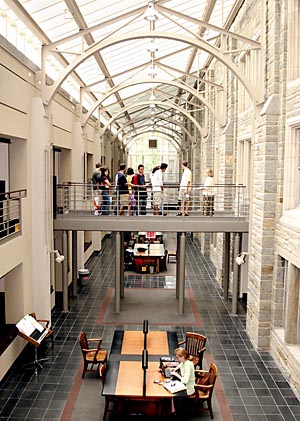Princeton Weekly Bulletin September 26, 2005, Vol. 95, No. 3 prev next
Class of 2009 reflects success of diversity efforts

Nearly 400 freshmen and new graduate students scouted the stacks on a tour of Firestone Library during an open house Sept. 13-14. The event was intended to familiarize new students with the resources of the library, which is one of the top 10 research libraries in the world. Here, library staff member Deborah Follansbee led a group through Firestone’s atrium.
Princeton’s class of 2009 represents continued success in the University’s efforts to diversify its undergraduate student body. This year’s freshman class includes record totals and percentages of financial aid recipients, low-income students and minorities.
A record 55 percent of the 1,229-member class is on financial aid, Dean of the College Nancy Malkiel reported at the Sept. 19 faculty meeting. That is the highest percentage at any Ivy League institution based on preliminary reports. Last year’s freshman class included 52 percent of students on financial aid.
Of the 675 freshmen on financial aid, 196 come from low-income households (defined as below $50,900 per year), up from 161 last year.
The figures represent a substantial increase compared to the class of 2001, the last class admitted before Princeton began revamping its financial aid practices. In that freshman class, 432 students—or 38 percent of the class—received financial aid, and 88 students were from low-income households.
“As the data … make plain, we have been tremendously successful in attaining our goal of making Princeton affordable for any student regardless of family financial circumstances,” Malkiel said. “The changes in financial aid policy have had a dramatic effect on the economic diversity of the undergraduate student body.”
In 2001, Princeton eliminated loans for all students who qualify for aid, expanding a program instituted three years earlier in which loans were replaced with grants for low-income students. The groundbreaking “no loan” program is part of a series of enhancements to Princeton’s aid program that began in 1998, including the adjustment of formulas for determining need to reduce the amounts that both students and families are expected to contribute.
The University received a record 16,510 applications for the class of 2009—an increase of nearly 21 percent from the previous year—in response to growing awareness of its financial aid advantages, as well as enhanced recruitment efforts and the introduction of Web-based application forms. Princeton also for the first time accepted submissions of the Common Application, a standardized form used by colleges and universities across the nation.
Reflecting the University’s efforts to attract a broader pool of applicants, the number of minority students in the class of 2009 rose to a record 433, or 35 percent of the class, from 321, or 27 percent, in the class of 2008.
“Building a strong multicultural community is a high priority for the University, and we will continue to concentrate on the recruitment, selection and yields of minority students in the applicant pool for the class of 2010,” Malkiel said.
The class of 2009 is Princeton’s largest freshman class, due to the University’s decision to start the planned expansion of its student body sooner. With the opening of Bloomberg Hall in 2004 and additional housing capacity currently available, the University was able to accommodate more students beginning this year rather than waiting until the opening of Whitman College in 2007.
The University will gradually increase the size of incoming classes over the next few years, with the undergraduate population projected to reach 5,200 students in the fall of 2012. Including the class of 2009, Princeton currently enrolls about 4,740 students.
The figures for the class of 2009 do not include 24 undergraduates who have been temporarily enrolled as visiting students at Princeton because they have been displaced from colleges and universities affected by Hurricane Katrina.
For additional figures on the class of 2009, see “By the Numbers” in the Sept. 11 issue of the Princeton Weekly Bulletin.

